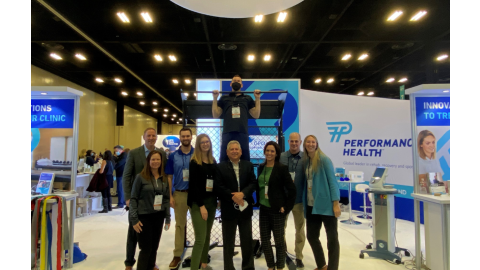There are a lot of steps to opening a new clinic or a de novo location – on top of finding a good venue, developing a business plan, and finding staff, you also need to determine what capital expenditures to make, including exercise equipment and treatment furniture. In this article, we’ve compiled a comprehensive list of clinical favorites you’ll need to get started.
Key Takeaways
Performance Health carries all the essential equipment for a new or de novo clinic
Having the right equipment will help you treat patients more effectively
These recommendations make it easy to choose the best equipment for your clinic
Consider both your patient load and the size of your space when making modality purchases
Table of Contents
Treatment Furniture
Hot and Cold Modalities
Electrical Stimulation and Ultrasound Units
Strength and Cardio Equipment
Gym Space
Recap
Top Products in This Article
Treatment Furniture
Treatment Tables
Generally, it’s recommended to have one treatment table per patient treatment room. However, there are many different types of treatment tables you can purchase, each with its own advantages.
For those with a tighter budget, standard mat treatment tables are a great starting point. Functional and affordable, they’re the most basic form of a treatment table, and they don’t have any fancy features.
Hi-lo tables, like the Performa Bar Activated 350 Table, are helpful for accommodating differing patient heights or mobility levels, and they allow for increased clinician comfort during treatment. Since they’re adjustable, hi-low tables are usually a little more expensive than mat tables but are still affordable.
Sectioned tables, like the Essential Thera-P Electric Treatment Tables, will be the most expensive, but they give the clinicians optimal control over patient positioning. They have several configurable sections that allow the legs, arms, or head to be positioned correctly during treatment.
Stools
Having a stool in patient treatment areas feels self-explanatory, but they are helpful to have around. They make it easy to transition between patient care, charting, and other responsibilities, and let’s face it – it's nice to have a seat every once in a while.
Mobile Workstation
We recommend matching the number of mobile workstations to the number of clinicians working in your clinic. Workstations make it easy to bring your computer with you for documentation, and they’re convenient for moving around the clinic as needed.
Hot and Cold Modalities
Hydrocollator
Heat therapy is a great way to relax muscles and improve blood flow,1 but that means you need to have heat packs ready to use and on-demand. That’s where hydrocollators come in – they maintain a consistent temperature for long periods of time to keep heat packs warm throughout the day. A hydrocollator will save you time and ultimately allow for better patient care.
We recommend the Chattanooga Hydrocollator Heating Unit or the Richmar HydraTherm for your clinic. The Chattanooga Hydrocollator is available in multiple sizes and made from stainless steel, while the Richmar HydraTherm has a lower required temperature and is rust resistant.
Cold Pack Freezer
Where heat therapy helps with muscle relaxation, cold therapy helps with relieving pain and inflammation.1 Once you have heat therapy covered with a heating unit, you'll also want a cold pack freezer for cold therapy. Chattanooga has two great options that we recommend: the ColPac Freezer or the ColPack Chilling Unit. The freezer is more compact and is front-loading, which makes for easy access to cold packs, while the chilling unit has a larger holding capacity and is top-loading. The cooling unit you need will depend on the number of patients your clinic treats.
Paraffin Bath
Moist-heat paraffin therapy is another common form of heat therapy and requires a paraffin bath. We recommend a bath with adjustable temperature settings, like the Performa Adjustable Paraffin Bath, to accommodate patients with different sensitivity levels.
Electrical Stimulation and Ultrasound Units
Electrical stimulation (or E-Stim) and ultrasound are both non-invasive therapy methods that can help accelerate healing. When used simultaneously, the two methods can produce positive patient outcomes. A modality that administers both is a great addition to any physical therapy clinic. We recommend the Intelect Legend XT, a convenient two-in-one machine that administers both E-Stim and ultrasound. The Intelect Legend XT also includes helpful features like patient data cards for customized settings.
Strength and Cardio Equipment
The main goal of any rehab regimen is to regain strength and function in the injured part of the body, so strength and cardio equipment are usually staple pieces in a physical therapy clinic. We’ve listed all our recommended products here, but you can see all strength and cardio equipment by clicking the buttons below.
Full Body Recumbent Stepper
These are ideal for total body functional movement, especially for those recovering from hip or knee surgeries who may have more limited mobility. A full body recumbent stepper emulates climbing a flight of stairs but removes the fall risk involved with an actual staircase, making it safer for patients to build strength.
Upper Body Exerciser
For rehabilitating injuries specific to the upper body, make sure you have a machine that focuses on building strength in (you guessed it) the upper body. The SciFit Pro Series has two great options for this kind of machine: the Total and Upper Body Exerciser can be used for upper, lower, and full body strength training, while the Pro1 Upper Body Exerciser focuses on solely upper body strength training.
Upright & Recumbent Bicycles
Stationary bicycles are great for improving endurance, strength, and cardiovascular health. Much like the recumbent stepper, recumbent bicycles are ideal for patients just starting their rehab regimen; upright bicycles are better suited for those further along in their recovery, as they provide a more full-body workout.
Treadmill
Not only are treadmills good for conditioning and endurance, they’re also helpful tools for examining gait, rehabilitating the back and lower extremities, and building strength. For your new clinic, we recommend a treadmill with medical side rails, like the SportsArt T655MS Medical Treadmill, to ensure greater patient safety.
Leg Press
A leg press is a great tool for improving strength and mobility in the legs. You don’t necessarily need weight plates for them, either – machines like the Shuttle MVP utilize body weight and resistance cords to create more challenging workouts.
Resistance Band Mounting Station
Resistance training is common in physical therapy programs, so having a resistance band mounting station is helpful for diversifying exercises involving resistance products. They’re great for improving strength, range of motion, and flexibility, and they save a lot of space in your clinic. We recommend the THERABAND® CLX® Wall Station.
Weight Storage Cart
A storage cart is convenient for keeping all your weights and resistance bands in one place. It keeps your clinic organized and makes smaller equipment easier to store and access. We recommend the Stor-Edge Multi-Purpose Carts, which include storage for both weights and resistance bands and come with casters for easy mobility. We suggest getting a set of dumbbells, cuff weights, and kettle bells to get started on stocking your storage cart.
Main Rehab Space
Parallel Bars
Gait training is often done using parallel bars, but this piece of equipment can also be used to help patients regain strength and balance. Depending on your clinic’s needs, you can choose from mounted or motorized parallel bars.
Staircase
Staircases are a great tool for helping patients get back to living independently at home. They help patients practice going up and down steps in a safe and controlled environment, all while building up strength.
There are a variety of staircases you can choose from based on the size of your clinic and the needs of patients. One-sided staircases require the patient to turn around once they’re at the top of the steps, while two-sided staircases allow patients to go up and down the steps without needing to pivot or turn. Convertible staircases can be configured as straight or corner stairs to meet every patient’s needs.
Plyometric Rebounder
Progressively improve strength and coordination with a plyometric rebounder, an incredibly versatile tool that can be used for both strength training and rehabilitation purposes. Plyometric rebounders create rhythmic, dynamic movements that can help stabilize the core, strengthen upper and lower extremities, and improve hand-eye coordination. They can even be used as trampolines to make therapy more fun!
Medicine Balls
Medicine balls are a staple at the gym, and they’re just as important for rehabilitation. They’re great for building back a patient’s strength, and they’re also used as accessories with plyometric rebounders.
Wheelchair
For patients who may have trouble getting around, it’s a good idea to have a wheelchair on hand. We recommend the Drive Cruiser III, since it’s adjustable and lightweight, making it easy to transport.
Laundry Hamper
If your patients will be using gowns or other linens while in your clinic, you’ll need a laundry hamper to collect those linens for washing. A hamper helps keep your clinic clean and can prevent germs or bacteria from spreading.
Recap
When starting a new or de novo physical therapy clinic, it’s important to have all the right equipment so you can treat patients effectively. This comprehensive list contains all the essentials you’ll need to get started, all of which you can find at Performance Health. Download the free equipment checklist below to get started!
Plus, when you shop with Performance Health, you get access to our Equipment Solutions Team, a crew of experienced project coordinators and certified technicians that will consolidate and coordinate delivery and installation of all your equipment for your new clinic. To learn more about our Equipment Solutions and Repair Services, click here!
Fill out the form below to receive your capital equipment checklist!
References
- Rodriguez, Diana. (2012). Heat or Cold for Chronic Muscle Pain? Everyday Health. Retrieved from https://bit.ly/3aFfT7F.
Medical Disclaimer: The information provided on this site, including text, graphics, images, and other material are for informational purposes only and are not intended to substitute for professional medical advice, diagnosis, or treatment. Always seek the advice of your physician or other healthcare professional with any questions or concerns you may have regarding your condition.








 France
France Australia
Australia















